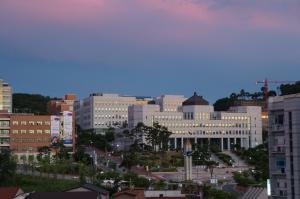Just like many other cultures, South Korea celebrates the changing of the seasons with unique dishes. From rice cake soup (Tteokguk) for New Year's Day to red bean porridge (Patjuk) which warms you up in winter, food plays a big role in Korean traditions. But what about spring? According to Dongkuk-sesigi, a record of Korean seasonal customs, spring is a time to enjoy azalea flower rice cake pancakes (Jindallae Hwajeon). Normally, this takes place on the third day of the third lunar month, Samjitnal.
 |
| ▲ Azalea Flower Rice Cake Pancakes (Photo from DKH) |
Samjitnal is a national holiday dedicated to soaking up the beauty of spring. This tradition of enjoying scenic spots with food, flowers, singing, and dancing is known as Hwajeon-nori. According to the Dongkuk-sesigi, even the royal court took part in Hwajeon-nori. The queen herself would be escorted to the Secret Garden for this springtime festivity. The star flower of Samjitnal is the azalea, typically in bloom in April. While resembling its cousin, the royal azalea, it has a unique characteristic: the flowers emerge before the leaves. Interestingly, traditional Korean medicine attributes health benefits to azaleas, suggesting they can help alleviate coughs, headaches, and bronchitis.
According to the Encyclopedia of Korean Folk Culture, Hwajeon is a delightful rice cake pancake made with seasonal flowers and glutinous rice flour. Generally, azalea and pear flowers are used in spring, roses in summer, and chrysanthemums in autumn. The recipe is simple; start by adding hot water to salt-mixed glutinous rice flour and knead it lightly. Then, put a small amount of dough into an oiled pan and form a flat, round shape. Lastly, decorate the dough with edible floral leaves and cook them over low heat. Due to its sweet taste, Hwajeon is often enjoyed as a traditional Korean dessert.
 |
| ▲ Hwajeon Baked in an Oiled Pan (Photo from DKH) |
The Dankook Herald (DKH) made azalea Hwajeon with international Dankookians (Students of Dankook University) in Haenggung-dong, Suwon. The teacher, an expert in crafting rice cakes, explained the recipe and its history, making the experience even more meaningful. Typically, the dough is made with glutinous rice powder, but we mixed some non-glutinous rice powder to balance out its bitter taste. We kneaded the dough with hot water, shaped it into small, round forms, and cooked them in a greased pan. When the dough became pellucid, we placed the azalea petals on top, flipped the dough briefly, and then let them cool on a plate strewn with sugar. After making the Hwajeon, we tried them with Sikhye, a Korean traditional beverage. The Hwajeon's sweetness, combined with its subtle floral bitterness, perfectly complemented the Sikhye's cool and slightly sweet taste. Furthermore, the pink hue of azaleas beautifully captured the vibrant spirit of spring.
 |
| ▲ DKH and international Dankookians are making Hwajeon using the recipe. (Photo from DKH) |
Ashly Marie Parsons (Freshman, Global Business Administration Major) expressed her thoughts, saying, “It was my first time visiting the area, and it was beautiful. I am really happy I got to experience a part of Korean culture.” Aurellia Billie (Freshman, Global Business Administration Major) also shared her delight, “I am glad that I got to make beautiful memories with nice people in a good environment!” She particularly enjoyed the experience of making Hwajeon and found learning about its origins and history to be enjoyable. Trainee reporter Yu then reflected on making Hwajeon, “When I put the flowers on the dough, I realized that shaping them was more challenging than I had anticipated. This made me appreciate Hwajeon-nori more as a delicate and beautiful cultural practice.” Reporter Lee from our team also found a new satisfaction in crafting Hwajeon from start to finish. Not only was it a delightful experience, but it also captured the spirit of a Korean spring day uniquely and charmingly. The recipe and ingredients were refreshingly simple, making Hwajeon the perfect activity for Dankookians to try themselves as well.
 |
| ▲ DKH and international Dankookians are trying the Hwajeon with Sikhye. (Photo from DKH) |
As May marks the end of spring, let's embrace the spirit of the season a little longer. Although campus life can be hectic with midterms and assignments, why not take a break and treat yourself to Hwajeon? It will transport you back to a beautiful spring day in Korea and offer you a moment of relaxation.
이채현, 박지윤, 이연우, 유은서 dankookherald@gmail.com

 Are You Ready to Enjoy DKU’s 2024 Spring Festival?
Are You Ready to Enjoy DKU’s 2024 Spring Festival?






